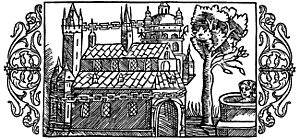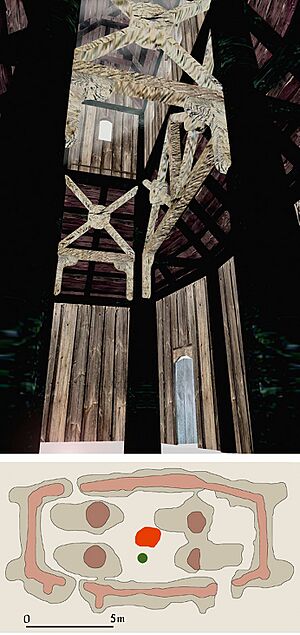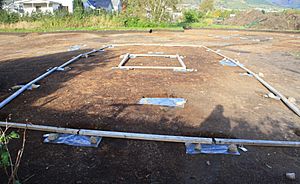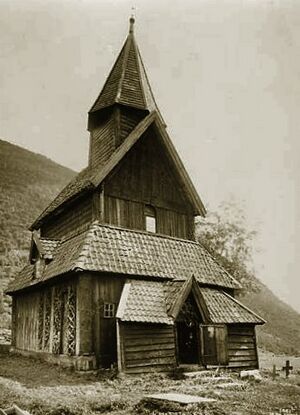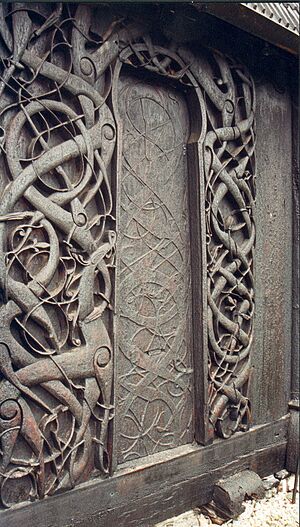Heathen hof facts for kids
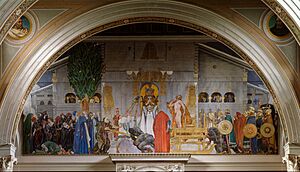
A heathen hof was a special building or place used for worship in ancient Germanic religions. Think of it like a temple for people who followed old Norse or Germanic beliefs before Christianity. The word hof comes from Old Norse, an ancient language spoken in Scandinavia. It originally meant a hall or a court, and later became known as a place of worship.
Contents
What is a Hof?
The word hof is similar to words in modern languages like Dutch and German. It first meant a large hall, like a meeting place or a royal court. Over time, it started to mean a temple. In the Viking Age, especially in Norway and Iceland, hof became the main word for a sacred place. Before that, people used other words like vé or hörgr.
Many places in Scandinavia are still named hof or hov. This shows where these important religious sites once were.
- Hov in the Faroe Islands.
- Hof in Norway.
- Hof, a village in Iceland.
- Hov in Sweden.
Some place names combine hof with other words:
- Hofstaðir in Iceland, where a hof was found.
- Norderhov in Norway, possibly linked to the god Njörðr.
- Torshov in Oslo, Norway, likely named after the god Thor.
There's even a village called Hoff in England, which had a "temple grove" nearby.
How Hofs Were Used
For a long time, experts debated what hofs really looked like. Some thought they were special buildings, just for religious ceremonies, like churches. They even believed hofs were often built on the same spots where churches later stood.
However, in 1966, a Danish archaeologist named Olaf Olsen studied many old sites. He found no clear proof that hofs were always separate temple buildings. He suggested that hofs might have been "temple-farms." This meant that the most powerful person on a large farm would also hold religious ceremonies and feasts there. So, the hof could have been a dwelling that also served as a religious center.
Later discoveries in the late 20th century changed these ideas again. Archaeologists found buildings in Scandinavia that seemed to be used only for worship. Some were linked to powerful leaders, like the hall at Tissø in Denmark. Others, like the one at Uppåkra in Sweden, were gathering places for everyone in the area. This suggests that both types of hofs existed. Richer areas might have had dedicated temples, while poorer areas used existing spaces for their rituals.
Hofs in Old Stories
Old stories and writings give us clues about hofs.
Iceland and Norway
In an old Icelandic book called Landnámabók, it says that Iceland was divided into four areas, and each had three hofs. Some sagas, like Kjalnesinga saga, mention hofs being surrounded by fences.
Sweden
Gamla Uppsala
The most famous hof from the Viking Age was at Gamla Uppsala in Sweden. A writer named Adam of Bremen described it around 1070. He probably heard about it from King Sweyn Estridsen, who had seen it himself.
Adam of Bremen wrote that there was a large, sacred grove next to the hof. In this grove, people and animals were sacrificed and hung from the trees. This was part of big ceremonies held every nine years.
Hofs Found by Archaeologists
Archaeologists have found the remains of several hofs, giving us a better idea of what they were like.
Denmark
Tissø
In the 1990s, archaeologists in Denmark found a chieftain's home near Tissø. They discovered a huge longhouse that was used for centuries. It had strong columns and might have been two stories tall. Inside, they found many animal bones, glass pieces, and musical instrument parts. This suggests it was used for important feasts and ceremonies.
Many valuable items were also found nearby, like a large gold ring and amulets. These finds show that the site was a major religious center for important people, possibly even kings. Kings were also religious leaders, so they would use these hofs for feasts and sacrifices when they visited.
Iceland
Hofstaðir
The name Hofstaðir itself means "place of the hof." Archaeologists have been digging here since 1908. They found a very long building, about 42 meters (138 feet) long. It had fireplaces and animal bones inside.
At first, some thought it was just a large farmhouse. But later excavations found even more animal bones. Analysis showed that at least 23 cattle had been sacrificed there. They were killed in a special way, by a blow to the head, and their skulls were displayed. This was unusual for farming at the time and suggests the building was indeed a hof, used for frequent religious gatherings.
Sweden
Uppåkra
Between 2000 and 2004, a heathen hof was found at Uppåkra in Sweden. This was a very important discovery because the site was undisturbed. The building was built and rebuilt six times over several centuries, always in wood.
The hof was not huge, about 13 meters (43 feet) long and 6.5 meters (21 feet) wide. It had very strong wooden columns in the center, almost a meter (3 feet) wide. It had three entrances. The main entrance was likely for men, another for women, and a third for a priest. Two large iron door rings were also found. This hof was near the center of a settlement and close to old burial mounds.
Lunda
At Lunda in Sweden, a hof was found connected to a longhouse. A nearby hillside also seemed to be a sacred grove. Many fire pits and crushed bones were found there, suggesting it was used for rituals.
Borg
At Borg in Sweden, a small building with two rooms was found. It had a stone foundation that might have been a hörgr, a type of altar. Many amulet rings and animal bones were found outside, suggesting ritual feasts. Later, this building was covered, and a church was built nearby.
Gamla Uppsala
Earlier excavations at Gamla Uppsala in 1926 found post-holes under the church. Some thought these were the remains of the great hof described by Adam of Bremen. However, later studies showed that the evidence was not strong enough to prove this. More recent digs in the 1990s found a very large hall near the church. This might have been a "hall hof," used for pagan festivals.
Norway
Mære
Under a medieval stone church at Mære in Norway, archaeologists found traces of a hof. This is the only hof found directly under a Norwegian church. Small gold figures called gullgubber were found in one of the post-holes.
Hov
At Hov in southern Norway, a 15-meter (49-foot) longhouse was excavated. It also contained gullgubber and other items suggesting it was used for religious purposes. This building was part of a farm but seemed to be used only for rituals, not as a home.
Ranheim
In 2011, remains of a heathen worship site were found at Ranheim in Norway. It included a stone circle, an altar, and a building with 12 large pillars. This building might have sheltered images of gods. The site dates back to about 400 CE and was covered with earth to hide it.
Ørsta
In 2020, a building about 14 by 7 meters (46 by 23 feet) was found at Ose in Ørsta, Norway. It had curved walls and four central pillars, similar to Uppåkra. This is believed to be a hof from the late Viking Age (around 970-990 CE). A piece of an iron plough was found in one pillar, likely an offering. Fireplaces were also found, used for heathen ceremonies.
Another smaller, round building was found nearby, also thought to be a hörgr (altar). These finds suggest Ose was an important central farm site for a very long time.
Anglo-Saxon England
Yeavering
The only heathen temple site found in England so far is at Yeavering in Northumberland. This was a royal residence for Anglo-Saxon kings. Archaeologists found several buildings, including one that was likely a temple. It was built in two stages and had a pit filled with animal bones, mostly from oxen. These animals were sacrificed in a specific way. The site also had burials nearby, some from heathen times.
Stave Churches
The unique medieval stave churches in Norway and Sweden were built using a similar wooden construction style seen in older hofs. The oldest, Urnes, even has old carvings that were considered too pagan and were moved to a less visible spot. Many people thought hofs might have looked like early stave churches.
However, archaeologists have found that while many early churches were built over older wooden churches, only the church at Mære in Norway has clear traces of a heathen hof underneath it. This suggests that hofs were not always directly replaced by churches on the same spot.
Modern Hofs
Today, some people who follow modern heathen religions have built or adapted buildings to be hofs.
- In 2014, the Odinist Fellowship in England dedicated a former chapel as a hof.
- In Iceland, the Ásatrúarfélagið started building a new hof in 2015, designed to fit into a hillside.
- The Asatru Folk Assembly has dedicated several hofs in the United States, including Odinshof in California (2015), Thorshof in North Carolina (2020), Baldrshof in Minnesota (2020), and Njordshof in Florida (2022). They are also planning a hof to Týr in Tennessee.
|


